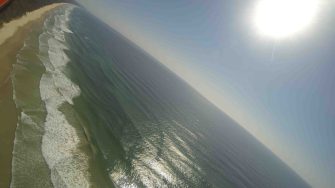
Date: Wednesday, October 8, 2014
Project: Eastern Australian Waterbird Survey
Observer: Richard Kingsford
“Very hot day today” blared the Maroochydore commercial radio, as we headed for the plane. That’s what we expect as we go north. Tomorrow’s leg from the Whitsundays to Mt Isa is always stifling heat. First survey stop – west to a reservoir in the mountains, draped in a veil of smoke in all directions.
Photo 1. Dam behind Noosa with a few swans and egrets.
A few more wetlands around Noosa and we were finished the eastern end of Band 7. There are 200km between each of our survey bands. So on north to the eastern edge of Band 8.
In between, there is the spectacular 200km coastal stretch, beginning with a flight north along the incredibly long Teerwah Beach north of Noosa, at least 20km long. Rays, sharks and bait fish swim in the shallows, easy to see from our plane. “There’s a big one” – said Peter from the back seat – officially he is the LBO or Left Back Observer. I am on the right hand side of the plane – officially the RFO, the Right Front Observer – looking seaward. Peter and the other Richard, the pilot, have the plum side of the plane. I have to lean over to see the good stuff, including a pod of about 30 porpoises moving effortlessly through the water and easily visible even when they dived because the water is so clear.
Photo 2. The incredibly long Teerwah Beach north of Noosa from the GoPro camera on the plane
Then over the spectacular Hervey Bay. A myriad of channels and islands stretch in every direction. These are dugong waters. And we are seldom disappointed as we fly north, spotting the odd individual. The tide is full and so these magnificent creatures aren’t as easy to see; many live here grazing seagrass meadows of one of Australia’s most important estuaries. Turtles also bob up and down like corks on either side of the plane, the density so high that you were seeing five at a time. Their heads pop up regularly, breaking the water as they come up for air. The size and complexity of mangroves, mudflats and shallow water shoals are a haven for wildlife. Even though we don’t survey this area, there are thousands of migratory shorebirds who have made their way from Russia and China in the last few months where they bred. An incredible journey for a small bird. Our small plane survey seems somewhat laboured in comparison.
Photo 3. Mangrove islands across Hervey Bay, a haven for migratory shorebirds, dugongs, turtles and whales.
The eastern side of Band 8 is north of Bundaberg. The band centres on Baffle Creek. This river system has undergone considerable development over 30 years of aerial survey flying. There are new agricultural crops like macadamias and fruit trees as well as and fish or prawn farms. It takes us about half an hour to survey the wetlands for relatively few waterbirds before we head north for lunch in Gladstone. This once sleepy coastal town is a hive of activity for the coal and gas industry. The estuary continues to radically be transformed into a port of massive dimensions. As if to underline this, there is a parking bay of 20 large coal ships parked on the horizon. Survey band 9 is about another 100km to the north.
Photo 4. Massive port development around Gladstone
The rivers that bring nutrients and freshwater out to the Great Barrier Reef are critical for its health. The next river to the north is the Fitzroy with its channels carving a maze of patterns across the mudflats and mangroves.
Photo 5. Intricate maze of channels created by the Fitzroy River as it goes out to sea.
It is here we start to see our first tropical waterbird species. Magpie geese, and white pygmy-geese. These wetlands seem to be incredibly productive with very high diversity and numbers of waterbirds. There is nearly always one two Jabirus (black-necked storks). One of them took off on my side of the plane, stretching out its huge black and white wings – a beautiful sight.
Photo 6. Flocks of egrets take off on wetlands north of Rockhampton where we start to see the tropical waterbirds
In the past, we have seen flocks of thousands of egrets and magpie geese on the wetlands of Band 9 and Band 10, the floodplain of the Proserpine River inshore of the Whitsunday Islands. But the spectacular flocks I remember surveying in the late 1980s and 1990s have been gone for some time. Just one of the many mysteries that gets one thinking about long data sets. We have seen the natural boom and bust cycles but here the booms seem muted over time, following a similar pattern to the Murray-Darling Basin. Perhaps the building of Proserpine Dam has contributed.
We head for our last coastal stopover at Airlie Beach after squeezing through the hills to land at the tiny airstrip at Shute Harbour. From now on, it is all inland as we head west towards Mt Isa, along our most northern survey band No. 10.
Map of flight path for Wednesday the 8th of October
